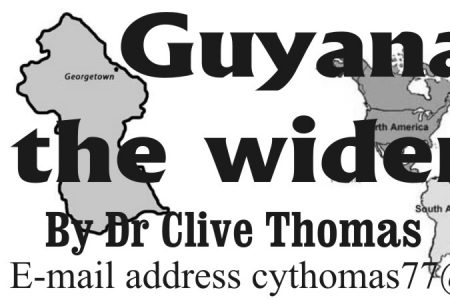
Is there a PPP/C government public investment strategy?
Introduction This week I am going to examine the PPP/C’s pubic investment strategy.

Introduction This week I am going to examine the PPP/C’s pubic investment strategy.

Introduction As earlier indicated I intend to merge the ongoing discussion of Guyana’s public investment management into what is, hopefully, a fruitful consideration of the National Budget, 2013.

Introduction: At the end of last week’s column I had indicated that, beginning this week, I would merge my on-going consideration of the decision-making process in regard to Guyana’s public investment projects into a wider discussion of the National Budget 2013.

Introduction In this week’s column I start with a wrap-up of the discussion on uncertainty and risk as applied to government projects and then go on to offer brief comments on the notion: time is money.

Introduction The list of troubled government projects in Guyana is long and getting longer by the day.

Introduction If, as I observed in last week’s column, removing the unrelenting glare of public scrutiny from government spending is a certain recipe for the entrenchment of waste and inefficiency, then one important corollary follows.

Scarcity and choice As a prelude to my intended discussion of the 2013 Annual National Budget after it is presented to the National Assembly later this month, in last week’s column I had started an appraisal of the management of government investment spending in Guyana.

Economic efficiency In last week’s column I concluded the series of columns commemorating the 30th anniversary of the Third World Debt Crisis (TWDC) and addressing the performance of Guyana’s public indebtedness since then.

Conclusion Policy options pursued This week I wrap up my columns commemorating the 30th anniversary of the Third World Debt Crisis (TWDC) and Guyana’s fortunes in this regard since 1982.

Part 3 Economic growth As I bring this discussion on Guyana’s public debt behaviour since 2006 to an end, I direct attention to its broader macroeconomic context.

Part 2 Introduction This week I continue the discussion of the burden of Guyana’s public indebtedness since the official introduction of its rebased 2006 price series GDP estimates.

Part 1 Problems of measurement For my remaining columns commemorating the Third World Debt Crisis (TWDC) I shall focus the discussion on Guyana’s public debt situation since 2006.

In this and the next couple of columns to follow, I shall broadly address Guyana’s public debt situation since the eruption of the Third World Debt Crisis (TWDC) in 1982, the year in which Guyana also announced its first default on its public debt obligations.

Global financial meltdown My efforts to draw readers’ attention to the fact that the Third World Debt Crisis, which started 30 years ago in Mexico (and as I noted Guyana also) is alive and well today is by no means intended to diminish the magnitude of today’s sovereign debt problems, which now centre on the First World economies.

Measuring debt burden As I proceed with the discussion of the debt crisis, the first issue that should be clarified is how to determine the burden of public or sovereign indebtedness among countries.

When I began my last series of Sunday columns (September 2, 2012) on the topic ‘Revisiting the political economy of the Guyana sugar industry’, which I concluded last weekend (December 23), I did not anticipate it would take as many as 17 weekly columns for a reappraisal of the industry with recommendations for its reform.

Part 2 This week I shall conclude my discussion of the reform of Guyana’s sugar industry started on September 2, 2012.

Mature industry Framing the reform of GuySuCo and the sugar industry must necessarily start with an identification of the major dynamics driving both.

Introduction Last week’s column covered the strategic role of maintenance in GuySuCo’s efforts to modernize the sugar industry.

Three policies For much of the period of the 2000s (and indeed for most of the presentation in this series of columns on sugar) attention has been chiefly directed towards the failure of the Skeldon Sugar Modernization Project (SSMP).
The ePaper edition, on the Web & in stores for Android, iPhone & iPad.
Included free with your web subscription. Learn more.